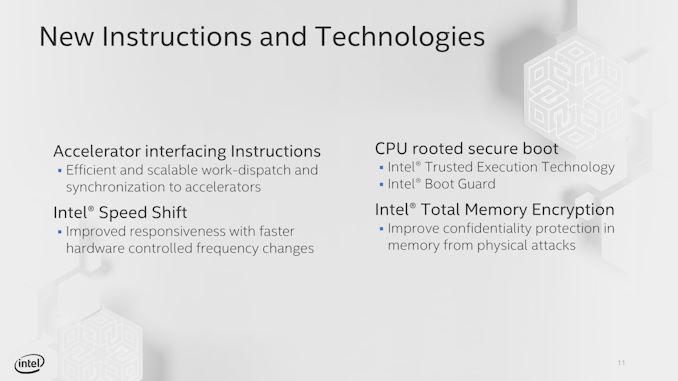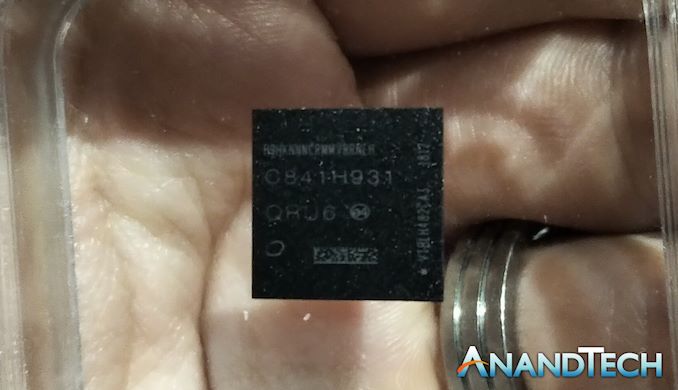Intel's new Atom Microarchitecture: The Tremont Core in Lakefield
by Dr. Ian Cutress on October 24, 2019 1:30 PM ESTBeyond the Core
Nominally today’s disclosure is more about the Tremont microarchitecture than any SoC it might appear in, like Lakefield or Snow Ridge. To that end, Intel wasn’t talking about GPU support (Lakefield will have Gen11 graphics), but Intel did discuss that Tremont would be the first Atom design to fully support Intel’s Speed Shift / ACPI hardware flags, allowing for faster ramp-up and ramp-down of high-frequency operation.
Intel also stated that Tremont supports Total Memory Encryption to prevent physical attacks, Rooted Secure Boot and Boot Guard, and specific accelerator interfacing instructions. With respect to Spectre, Meltdown, and L1TF, Intel stated that Tremont will have the same protections as Cascade Lake.
We also asked Intel about module-level voltage and power control. We were told that within a quad-core module with four Tremont cores, all the cores share the same frequency plane, but each core can enter separate c-states to reduce power consumption when not in use.
Final Thoughts and Slide Deck
In the past, at least from my perspective, dealing with Atom platforms has been amusing. Atom devices typically work great for hyper-focused and optimized software that can take advantage of a latency-insensitive workload, such as networking equipment or a NAS, but for any general purpose use I find them incredibly slow. Perhaps I’m just too used to the big cores on the devices I use – but with Intel saying that Atom is being refocused on performance, it will be interesting to see how Tremont devices and other Core devices will overlap. This graph from Intel is very striking, and if you squint, it looks a lot like some of the smartphone power/performance graphs we’ve produced in the past.
With Intel moving Core down in power to the 1.5W level, again it will be interesting to see how Tremont can play in that 2mW to 2W range that Atom has traditionally played in. The last generation Goldmont Plus devices were going beyond that, and in this power range we also have smartphone cores coming into play. After showing the slide deck to Andrei, we were discussing how a Tremont might stack up against an Arm Cortex A76, or a Kryo core. When we can get our hands on Tremont, we’ll see how they compare. When it comes to the products that Tremont is aiming for however, it still has that x86 advantage.
We did ask a few questions from Intel that we didn’t get answers to, such as die size and target frequencies. The other question to discuss is Intel’s current high-demand issues putting pressure on its manufacturing technologies. Tremont is still a low cost, low powered core, so logic may dictate that it will be a while before we see consumer chips enter the market. Ultimately Intel’s high-demand issues are around 14nm, and so far we’ve only seen Tremont discussed on Intel’s 10+ process with Lakefield and Snow Ridge. What we know about Intel’s 10nm/10+ capacity isn’t a lot, but reports vary from yields being ‘on track’ to ‘working with key OEM partners only’. Intel’s driver for 10+ right now is Ice Lake, which is coming to some premium notebook designs this year, and Lakefield has been announced for the Surface Neo. It is not known what the expected volume for the Neo will be, but it is unlikely to be large. Whether or not Tremont will see the light of day in traditional Atom Celeron and Pentium processors is another question entirely – the Goldmont Atom families have suffered while Intel’s 14nm efforts are more focused on enterprise hardware that can be sold for a much higher $$ per square millimeter. Beyond Lakefield, we might not actually see Tremont in any other consumer chip before the next generation Atom if Intel cannot get its issues sorted.
As and when we get a Lakefield device, we will put it through our tests. Stay tuned.













101 Comments
View All Comments
eddman - Saturday, October 26, 2019 - link
MP4 is a container, not a codec.Alien959 - Friday, October 25, 2019 - link
I am reading this article on goldmont + powered laptop. While definitely is not a speedster, the hardware is perfectly usable for light tasks like internet browsing, text editing I even did some 1080p edits in premiere and some modeling in SketchUp pro. It handles the tasks fine. The rest of the hardware is a ssd and 8 gb of ddr4 ram. The main reason what makes the system usable is that the GPU is supported in both programs, and that alleviates the speed of weaker cores on the CPU side.Bigos - Friday, October 25, 2019 - link
> The two ALUs have one focused on fused additions (FADD), while the other focuses on fused multiplication and division (FMUL).Did you mean *float* instead of fused? The only thing that comes to my mind when you say "fused" is FMA: fused multiply-accumulate.
Also, in the "New Instructions" section the table is titled "TITLE", which sounds amusing but is probably a left-over.
mode_13h - Saturday, October 26, 2019 - link
Yeah, this was also mentioned above. You are correct, as I said in my reply to @ternnence.snakyjake - Friday, October 25, 2019 - link
If it works for HTPC, decodes HEVC efficiently, low power, low heat, fanless, then I'll buy it.Namisecond - Friday, November 1, 2019 - link
The current Goldmont+ chips already do all that.ksec - Saturday, October 26, 2019 - link
Not useful without pricing. In terms of absolute numbers in both Performance and power, ARM or POWER has readily available solutions.Elstar - Saturday, October 26, 2019 - link
The dual frontend decoders seem ideal for SMT performance. I'm surprised they don't have that option for those that want it.TomWomack - Sunday, October 27, 2019 - link
'1.5 MB will be a 12-way design, while 4.5 MB will be an 18-way design. (We therefore assume that a 3.0 MB L2 will be 15-way'1.5MB 12-way would be 12 256kb blocks; 4.5MB 18-way would be 18 512kb blocks; 3.0MB would be either 24-way with 256kb blocks or 12-way with 512kb blocks, almost certainly the latter
AshlayW - Sunday, October 27, 2019 - link
Intel's new SoC design with "low power" and "high power" cores, akin to the big.LITTLE from ARM, is actually pretty awesome. I'll give them credit where it's due, Sunny Cove, and Tremont are shaping up to be fantastic architectures - for low power mobile, an area where I'd love to see more super tiny low power x86 devices, as I have grown quite fond of my HP envy X360, even though it has the comparatively less efficient Raven Ridge silicon in it (2500U).It's just a shame they won't have anything interesting on the desktop. I'll tell you what, Intel. If you want my custom, get these ULP chips into something like a One mix Yoga 3, and I might even buy it. Now imagine playing Warframe, on the go, on a device I can slip in my pocket with a wireless Xbox Controller in the other one. Make it happen.